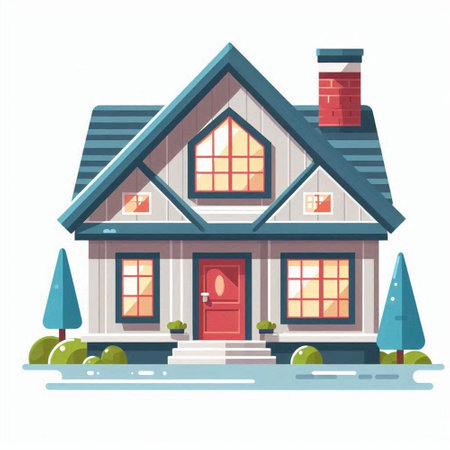Introduction to Period Properties and Their Unique Appeal
Period properties in the UK are a hallmark of architectural heritage, offering a tangible link to the country’s rich history. Defined broadly as buildings constructed before World War II, these homes span several distinct eras, including Georgian, Victorian, and Edwardian periods. Each era is characterised by its own unique features—from ornate cornices and sash windows to grand fireplaces and intricate mouldings—which collectively contribute to their enduring charm. The allure of period properties lies not only in their aesthetic beauty but also in the craftsmanship and materials that have stood the test of time. These homes are highly sought-after by those who value authenticity, character, and a sense of continuity with the past. However, owning or renovating a period property comes with its own set of challenges, particularly when it comes to integrating modern amenities such as lighting solutions while preserving the building’s historic integrity. Understanding the delicate balance between old-world charm and contemporary functionality is essential for anyone looking to enhance their period home without compromising its unique appeal.
2. The Challenges of Lighting in Historic Homes
Updating lighting in period properties presents a unique set of challenges that often extend beyond mere aesthetics or practicalities. Many historic homes across the UK are subject to stringent listed building regulations, which aim to preserve the architectural integrity and cultural significance of these treasured buildings. Property owners must navigate complex rules set out by local planning authorities, particularly when dealing with Grade I or Grade II listed buildings. These regulations frequently restrict alterations that might affect original features, such as ornate plasterwork ceilings, cornicing, or antique timber beams.
Beyond regulatory constraints, another significant hurdle is integrating modern lighting systems without compromising the historic character of the property. Original electrical wiring may be outdated or insufficient for contemporary lighting needs, yet replacing it wholesale risks damaging period details. This delicate balance between upgrading functionality and maintaining authenticity can be difficult to achieve.
Common Issues Faced When Upgrading Lighting
| Issue | Description |
|---|---|
| Listed Building Consent | Obtaining approval for changes that impact protected features can be time-consuming and may result in limitations on fixture types or installation methods. |
| Preservation of Features | Original ceilings, mouldings, and wall surfaces may not allow for recessed fittings or concealed wiring without irreversible alteration. |
| Electrical Safety | Historic wiring systems often fall short of modern safety standards, necessitating careful upgrades that do not compromise structural elements. |
| Aesthetic Consistency | Selecting fixtures that complement both the age of the property and contemporary requirements can prove challenging. |
Navigating Regulatory Requirements
For any works involving the alteration or introduction of new lighting systems, owners must be proactive in consulting with conservation officers and obtaining all necessary permissions before commencing work. In some cases, sympathetic solutions such as wireless controls or surface-mounted conduits painted to match existing décor offer a way forward without breaching guidelines.
Conclusion
The process of updating lighting within period properties requires thoughtful planning and an understanding of both regulatory frameworks and the intrinsic value of original features. By recognising these challenges early in the design process, property owners can blend modern functionality with historic charm while respecting legal obligations and heritage considerations.

3. Modern Lighting Solutions that Complement Heritage Settings
Integrating contemporary lighting into period properties requires a delicate balance between preserving historical character and introducing the benefits of modern technology. Today’s market offers a diverse array of lighting solutions specifically designed to respect architectural heritage while delivering on energy efficiency and user convenience. LED technology stands out as an especially suitable option for heritage homes, providing excellent illumination with minimal energy consumption and heat output. Unlike traditional incandescent bulbs, LEDs come in a wide spectrum of colour temperatures and fitting styles, including candle-shaped bulbs and bayonet caps that echo vintage designs.
Another significant advancement lies in smart lighting controls, which allow homeowners to manage light levels remotely or through discreet wall switches. These systems can be retrofitted without disturbing original plasterwork or cornicing, thereby maintaining the integrity of interior features. Dimmable fixtures and programmable settings enable homeowners to create different ambiences for entertaining or relaxing, all while conserving energy.
For those seeking to minimise visual impact, recessed spotlights and low-profile track lighting can be installed in less conspicuous areas, such as behind beams or within alcoves. This ensures functional illumination without drawing attention away from period detailing. Additionally, wireless fittings reduce the need for invasive wiring routes, further safeguarding the historic fabric of the property.
It is essential to select finishes and fixture styles that harmonise with existing décor—antique brass, aged bronze, or matte black fittings often complement older interiors seamlessly. By carefully considering both aesthetic compatibility and technological performance, homeowners can achieve a sophisticated blend of old and new that enhances daily living while honouring the legacy of their period home.
4. Respecting Authenticity: Sourcing and Selecting Fixtures
When illuminating a period property in the UK, it is vital to approach the selection of lighting fixtures with both reverence for historical accuracy and consideration for modern needs. Sourcing fixtures that are true to the era not only preserves architectural integrity but also enhances the overall aesthetic value of your home. However, balancing authenticity with current functionality and compliance with safety standards requires thoughtful evaluation.
Understanding the Era’s Lighting Styles
Each architectural period, whether Georgian, Victorian, or Edwardian, boasts distinct lighting characteristics. Homeowners should begin by researching the typical materials, shapes, and finishes prevalent during their property’s era. Consulting local heritage resources or referencing reputable UK antique lighting suppliers can guide you towards fixtures that echo original designs.
Balancing Authenticity with Modern Functionality
While restoring original fixtures or sourcing genuine antiques is ideal, these may not always meet contemporary safety regulations or practical needs. It’s essential to ensure all fittings are compatible with modern wiring, bulbs, and energy-efficient technologies. Many UK manufacturers now offer faithful reproductions equipped with up-to-date electrical components, allowing you to maintain period charm without compromising on safety or efficiency.
Key Considerations When Selecting Fixtures
| Criteria | Authentic Option | Modern Equivalent | Compliance Tips |
|---|---|---|---|
| Design & Finish | Antique brass chandeliers, cut-glass pendants | Reproduction fittings in traditional styles | Select certified suppliers; request compliance documentation |
| Functionality | Candle sconces or oil lamps (restored) | LED-compatible wall lights in period design | Ensure all installations comply with BS 7671 wiring regulations |
| Safety | Refurbished vintage fittings (rewired) | Newly manufactured fixtures using safe materials | Engage NICEIC-registered electricians for fitting work |
| Sustainability | Salvaged originals from reclamation yards | Bespoke replicas made from eco-friendly materials | Consider energy ratings and bulb compatibility |
Sourcing Advice Specific to the UK Market
The British market offers an array of specialists dealing in both genuine antiques and high-quality reproductions suitable for listed buildings. Seek out vendors with expertise in your property’s era, and don’t hesitate to request provenance or manufacturer’s certification. For listed properties, consult your local conservation officer before making significant alterations to original lighting schemes.
Ultimately, successful period property lighting is about harmonising the charm of bygone eras with today’s standards of comfort and safety—ensuring your home remains both historically resonant and practically welcoming.
5. Installation Considerations and Legal Compliance
When updating lighting in period properties, both landlords and homeowners must address a range of practical and legal requirements to ensure that any installations are safe, sympathetic to the property’s heritage, and fully compliant with UK law. Understanding these obligations is critical, particularly for those who own or manage listed buildings, as unauthorised works can lead to significant penalties.
Listed Building Consents
If your period property is listed, any changes that affect its character—including electrical upgrades or light fixture replacements—may require listed building consent from your local planning authority. This applies to both interior and exterior features. Failing to secure proper consent before commencing work can result in enforcement action, including orders to reverse the changes at your own expense.
Compliant Wiring Standards
All electrical installations must adhere to current British Standards, specifically BS 7671 (IET Wiring Regulations). For period homes, this often means rewiring outdated systems while taking care not to disturb original architectural elements. In many cases, it is advisable to use surface-mounted conduit or existing voids to minimise damage to historic fabric. Only NICEIC-registered electricians or similarly qualified professionals should undertake this work, ensuring compliance with Part P of the Building Regulations.
Respecting Historic Features
Installation methods must be tailored to protect and preserve the unique features of period properties—such as ornate plasterwork or exposed beams. Landlords and owners should consult with conservation officers or heritage consultants early in the planning stages to avoid costly mistakes. Using reversible fixing methods and avoiding permanent alterations will help maintain the building’s historical integrity.
Ensuring Safety and Insurance Validity
Proper certification upon completion of electrical works is essential for both safety and insurance purposes. Certificates such as the Electrical Installation Certificate (EIC) or Minor Electrical Installation Works Certificate (MEIWC) provide evidence that the installation meets regulatory standards. Failure to obtain and retain these documents can compromise insurance claims and leave property owners liable in the event of an incident.
In summary, blending modern lighting with historic charm in period properties requires careful navigation of legal processes and technical standards. By securing all necessary consents, employing qualified professionals, and prioritising sensitive installation practices, landlords and homeowners can achieve a harmonious balance between contemporary functionality and preservation of heritage character.
6. Case Studies: Successful Lighting Upgrades in UK Period Homes
Victorian Terrace in Bath: Discreet LED Integration
A Grade II listed Victorian terrace in Bath exemplifies how homeowners can sensitively upgrade lighting while preserving period features. The owners worked closely with a conservation officer and specialist contractor to install low-profile LED strips beneath original cornicing, providing ambient light without damaging plasterwork or requiring invasive wiring. Discreet dimmer switches were selected to match the existing brass fittings, ensuring compliance with listed building consent and retaining the home’s historic character.
Georgian Townhouse in Edinburgh: Statement Chandeliers with Smart Controls
This Georgian townhouse underwent a lighting transformation that combined opulent period chandeliers with modern smart control systems. The design team sourced antique fixtures compatible with energy-efficient LED bulbs, reducing running costs and environmental impact. Advanced wireless dimming controls were installed, eliminating the need for rewiring and thus preserving ornate wall panelling. This approach respected both legal obligations under heritage regulations and the aesthetic integrity of the property.
Tudor Cottage in Kent: Layered Lighting for Functionality and Ambience
Owners of a 16th-century Tudor cottage faced challenges balancing rustic beams with contemporary living needs. They opted for layered lighting—recessed uplighters highlighted timber ceilings, while concealed task lights provided practicality in kitchens and bathrooms. All electrical work was undertaken by certified professionals familiar with Part P Building Regulations, ensuring that safety standards were met without visible disruption to the period fabric.
Legal Compliance and Best Practices
Across these case studies, one common thread is strict adherence to planning permissions and statutory requirements relevant to listed or conservation area properties. Early consultation with local authorities, use of reversible interventions, and engagement of qualified electricians ensured all upgrades met legal standards while enhancing both function and charm.
Conclusion: Inspiration for Responsible Renovation
These real-life examples demonstrate that blending modern lighting technology with historic architecture is achievable without compromise. Through careful planning, sensitive installation, and respect for heritage legislation, period homeowners can enjoy contemporary convenience while safeguarding the unique character of their properties.


